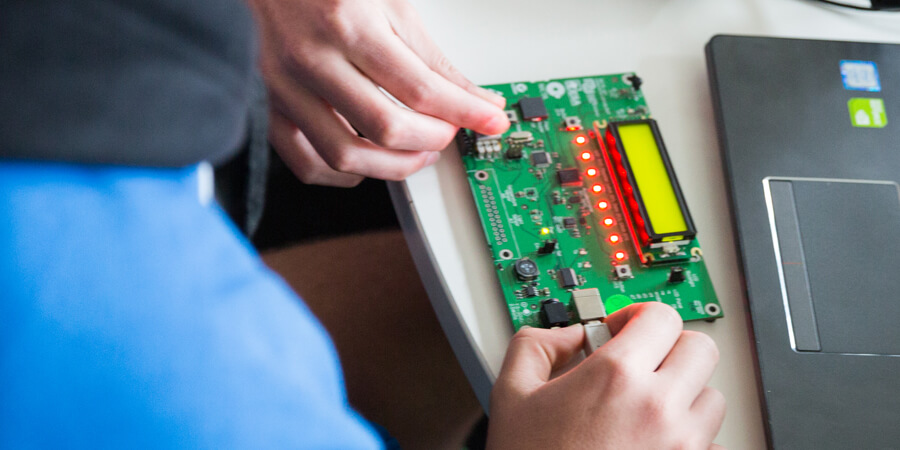
Course information
This course explores automation and physical computing through the engineering disciplines of robotics and mechatronics. The course introduces fundamental principles of both electronics and mechatronics before investigating microcontrollers that can be programmed to drive electrical circuits and mechanical systems.
Students apply their knowledge to the design and construction of real systems, examining how these solutions address problems, needs and challenges faced by individuals and societies. They design and program control software for autonomous and manual interfaces, correcting for noise and unexpected variations in data inputs and processing.
Robotics and Mechatronics aims to build theoretical and practical knowledge to prepare students for technical pathways such as engineering, IT, electronics and science.
Post-school pathways
The Robotics and Mechatronics course explores a range of ideas that are fundamental to success in the IT and Engineering industries, in formal university qualifications and research, and give students a strong grounding for future success in all areas that require competence in general Information Technology knowledge.
The courses also provides students with opportunities to develop competencies that work towards Vocational Education Certification in Information Technology that complements future studies at CIT. This includes the option of undertaking Structured Workplace Learning (SWL) or engagement in an Australian School Based Apprenticeship (ASBA).
Workload expectation
Tertiary students are expected to spend a minimum of four hours per week outside of scheduled class time on practicing the skills learned in class on a range of problems and activities. This includes both formal assessment items and preparation for tests.
Course patterns
Available as a Minor or Major, however, it may be combined with Networking and Security or Digital Technologies for a Major-Minor or Double Major in Information Technology.
Organisation of Content
The following are descriptions of the individual semesters you could study in this course.
Building & Programming Circuits
This unit of study provides opportunities for students to learn about the components of electronics and the design and construction of electronic systems. Students will use design methodologies to investigate, strategise, prototype, evaluate and critically analyse the construction of electronic systems being mindful of and practising Workplace Health and Safety compliance. Students will gain the skills and knowledge necessary to apply the design process using electronics to create innovative and sustainable systems.
Digital & Analog Interactions
This unit of study provides opportunities for students to learn to identify and respond to a real-world need and justify creation of a complex control system.
Students will investigate and program microcontrollers and control systems.
Students will apply the design process to design interface circuits, prototype and construct systems to receive input and collect data from sensors and provide meaningful output.
Robotics & Mechatronic Systems
This unit of study provides opportunities for students to investigate the development of robotics and mechatronic systems. Students critically analyse the effect that robotics and mechanised systems have on human society, built and natural environments and general well-being. Student will use the design process to create and control a product/ solution incorporating mechanical, electrical and control systems.
Applications of Robotics
This unit of study provides opportunities for student to investigate the role of robots and other intelligent machines, including artificial intelligence, machine learning, etc, and the design, construction and application of robotic systems. Students will use system architecture methodologies and the design process to complete a project; prototyping, constructing and evaluating an innovative system. Students will analyse their results and present their findings with justification
Negotiated Study
In this unit, students will study an area of special interest to be decided upon by a class, group(s), or an individual student in consultation with the teacher and with the Principal’s approval. The program of learning for a Negotiated Study unit must meet all the content descriptions as appear in the unit.
Computer Requirements
Please note that the Chrome Operating System used on Chromebooks is not compatible with the specialist software used in Information Technology. It is expected that students studying Information Technology have a computer that meets the following specifications:
| Stream | Operating System | CPU | Memory | Graphics | Peripherals |
|---|---|---|---|---|---|
Robotics and Mechatronics, Networking and Security, and Programming Stream | Windows, Mac, or Linux Operating System | Dual-core Intel or AMD CPU | 8 GB RAM | - | - |
Games Development Stream | 64-bit Windows 10+ or Mac OS X10.10+ | Quad-core Intel or AMD CPU – 2.5GHz or faster | 16-32GB RAM | Dedicated Graphics Card* | Three-button mouse |
* This cannot be an on-chip GPU for Windows PCs as the Game development programs are graphic intensive. M1/2 Macbook Pros can work, but will need a minimum of 16 GB of ram as it is shared between the GPU and CPU.
